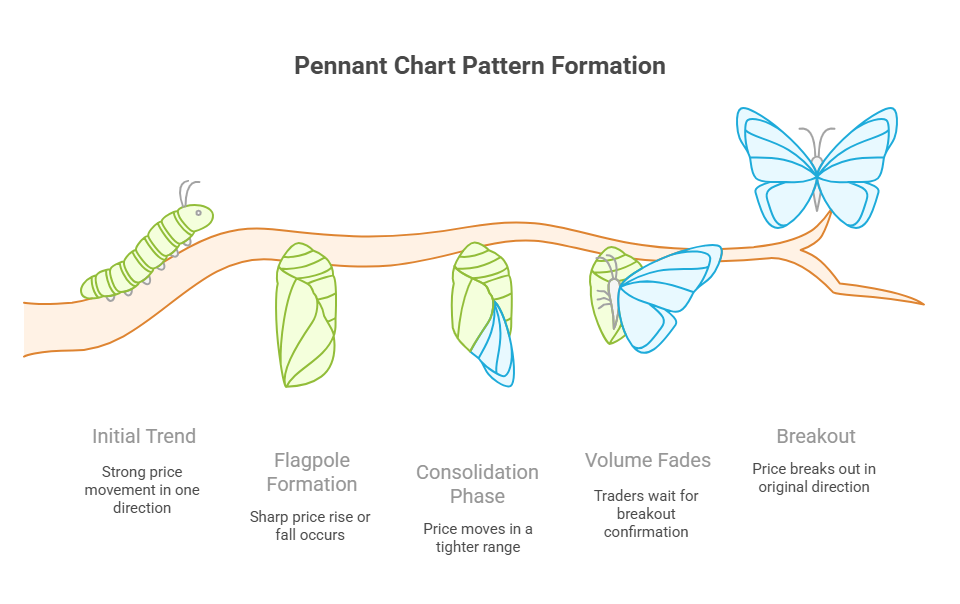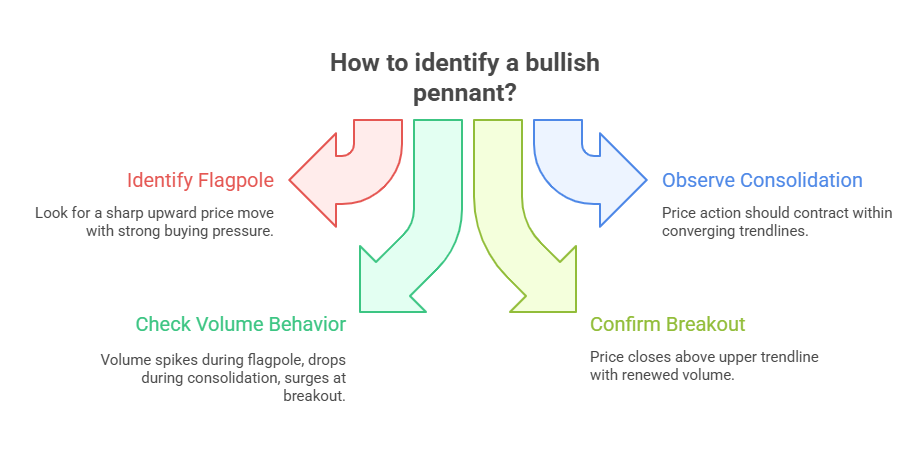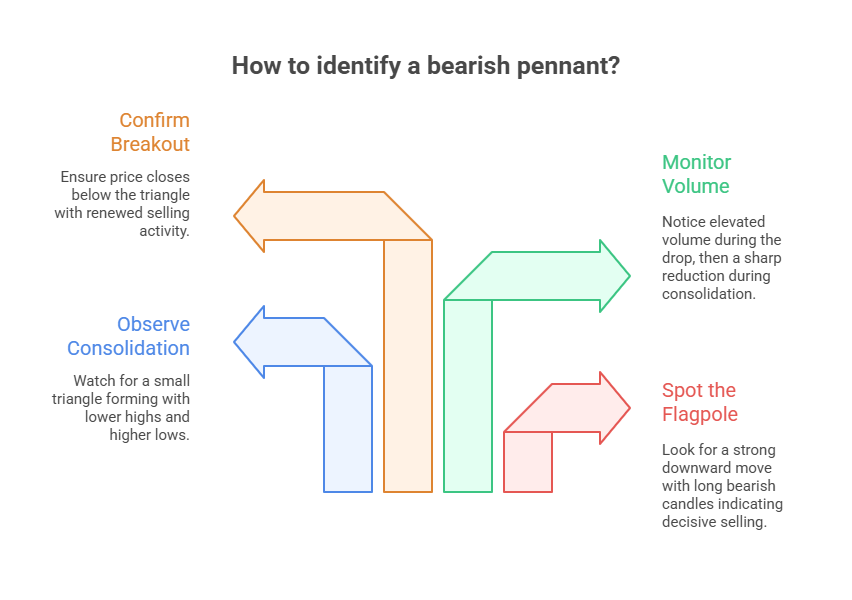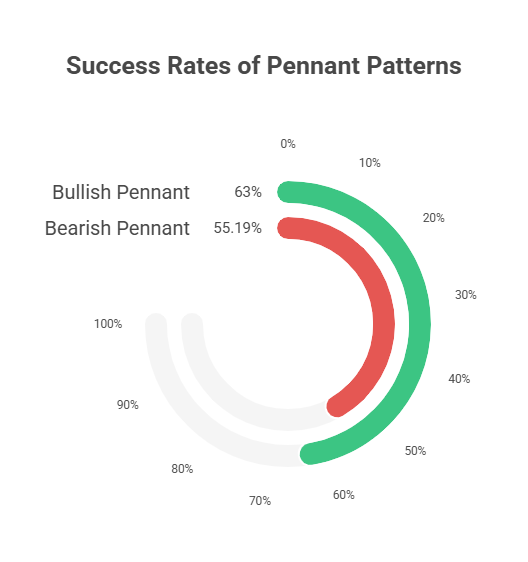The pennant market setup is one of the most recognizable formations in technical analysis. You might come across it in stock, commodity, or crypto trading, but it holds just as much weight in Forex.
In this guide, you will learn exactly what a pennant chart pattern means in technical analysis, how it shows up in Forex trading, and how you can spot, confirm, and trade it with confidence.
We will also go through bullish and bearish pennants, the key steps for identifying them, common mistakes to avoid, and tips for getting better results. By the end, the idea of a pennant market will feel clear and ready to apply in your trading plan.
What is a Pennant in Forex Trading?
A pennant is a continuation chart pattern in technical analysis. You can see it on forex price charts as a compact, triangle-like figure that marks a brief consolidation inside an existing trend. Analysts classify it alongside flags and triangles within the family of continuation patterns used to organize price behavior.
Example:
Let’s say EUR/USD has been climbing strongly for several hours. Then, instead of reversing, the price begins to move in tighter highs and lows, forming a small symmetrical shape. That shape is the pennant. It signals that the market is catching its breath, much like a runner slowing down for a moment before continuing the race.
What Does it Mean By Pennant Market in Forex?
Well, we can say that a pennant market in forex is the specific market condition marked by price staying contained inside a pennant pattern. The setup comes after a strong directional move, followed by a short consolidation shaped like a small symmetrical triangle.
In this phase, price action shows converging highs and lows, with each candle closing inside a narrowing range. Analysts, including Thomas Bulkowski in Encyclopedia of Chart Patterns, classify this stage as part of a continuation sequence rather than a full reversal.
Now it must be clear that the term “pennant market” simply refers to the market being in that consolidation period: a defined pause within an existing trend before any new movement direction is confirmed.
How does Pennant Chat Pattern Work and Form?

You first see a sharp price rise or fall called the flagpole. That strong push often follows events such as a surprise interest rate change or a major economic report. In March 2023, for example, GBP/USD surged over 180 pips within hours after unexpected UK inflation data — a move that set the stage for a textbook bullish pennant.
Once that surge cools, the market shifts into a brief consolidation phase. Price begins moving in a tighter range. The highs edge lower, and the lows edge higher, which gives the formation its compact triangular shape. In June 2024, EUR/JPY showed this behaviour after a 250-pip rally on ECB rate comments, with candles compressing into a neat triangle over four trading sessions.
It is notable that volume often fades during this phase, which shows that traders are waiting. Early entrants secure profits, and new participants plan entries. Basically, this “coiling” of price builds pressure much like a compressed spring. So, when price finally breaks out of the triangle, it often moves in the same direction as the original surge. For example, in August 2024. a breakout (on USD/CAD) from a bearish pennant extended the prior downtrend by another 120 pips within two days.
Key Characteristics of a Forex Pennant Pattern
- Price starts with a sharp move in one direction called the flagpole.
- A brief consolidation follows, forming converging trendlines.
- Highs slope downward while lows slope upward, creating a compact triangle shape.
- Volume spikes during the flagpole, then tapers off during consolidation.
- Breakouts often continue in the same direction as the flagpole.
How to Identify a Bullish Pennant?
A bullish pennant is a continuation chart pattern that signals a likely extension of an existing uptrend. According to Equiti (2024), it forms in three parts: a strong upward flagpole, a brief consolidation inside converging trendlines, and a breakout to the upside supported by higher trading volume.

You can spot a valid bullish pennant by following these steps:
- Identify the Flagpole
Look for a sharp upward price move with clear momentum. Candles should show strong buying pressure, often triggered by news or high-impact data releases. - Observe the Consolidation Phase
Price action should contract within two lines that slope toward each other, forming a small triangle. The range narrows as the market pauses. - Check Volume Behavior
Volume often spikes during the flagpole’s rise, drops during consolidation, then surges again at the breakout. This volume pattern helps confirm trend continuation. - Confirm the Breakout
The pattern is validated when price closes above the upper trendline with renewed buying volume. Conservative traders may wait for a retest of the breakout level before entering.
For example, in GBP/USD on a 1-hour chart during a Bank of England statement, a sudden rally formed the flagpole. A tight pennant followed, then price broke upward with high volume, matching the flagpole’s height in projected movement.
How to Identify a Bearish Pennant?
A bearish pennant signals the potential continuation of a downtrend after a short pause.
ThinkMarkets explains that it follows the same logic as a bearish flag but forms a triangular body instead of a rectangle, with lower highs and higher lows converging toward each other. Moreover, Equiti emphasizes the role of three elements: a sharp drop known as the flagpole, a brief consolidation phase, and a decisive breakout below support.

Follow this checklist to identify it clearly:
- Spot the Flagpole
Look for a strong downward move with long bearish candles. The move signals decisive selling in the market. - Observe the Consolidation
Watch price form a small triangle as highs slope lower and lows slope higher. That shape appears briefly before the next move. - Monitor Volume
Notice elevated volume during the drop, then a sharp reduction during consolidation. Volume should rise again at the breakout. - Confirm the Breakout
A valid bearish pennant shows price closing below the triangle with renewed selling activity. ThinkMarkets suggests waiting for a candle close to confirm the breakout before entering the trade.
For example, EUR/USD drops sharply after dovish central bank comments, then compresses into a small pennant over a few bars. Price breaks lower on fresh volume to complete the pattern.
How to Trade a Pennant Pattern?
A Pennant pattern works as a continuation signal, which shows that the market paused before likely pushing in the same direction. Right? So, you need to trade it well in order to confirm each element of the setup before committing capital.
1. Validate the Trend and Flagpole
A Pennant begins with a strong directional move known as the flagpole.
- In a bullish setup, price should create a sequence of higher highs and higher lows.
- In a bearish setup, prices should show lower highs and lower lows.
- The flagpole should be visible on higher timeframes such as the 4-hour or daily chart for higher reliability.
For example, EUR/USD climbing 150 pips over several bullish candles before pausing.
2. Confirm the Consolidation Phase
Once the flagpole completes, price should start moving within converging trendlines.
- The consolidation body must look like a small symmetrical triangle.
- Volume usually drops as the pennant forms, showing reduced trading activity before the breakout.
- Avoid counting random sideways moves as valid pennants — both trendlines must slope toward each other.
3. Identify the Breakout Level
The breakout direction must align with the flagpole’s trend.
- For bullish setups, focus on the upper trendline.
- For bearish setups, focus on the lower trendline.
- A breakout candle should close clearly beyond the trendline, not just spike past it.
For example, GBP/JPY closing above the pennant’s upper line on increased volume.
4. Plan Entry and Stop-Loss
Entry is best placed at or just after the breakout candle closes.
- In bullish trades, enter long once price closes above the upper trendline.
- In bearish trades, enter short once price closes below the lower trendline.
- Stop-loss placement:
- Bullish trade → a few pips below the lowest point of the pennant.
- Bearish trade → a few pips above the highest point of the pennant.
5. Set a Measured Take-Profit Target
Use the flagpole’s height to project a realistic profit target.
- Measure the number of pips from the start of the flagpole to its top (bullish) or bottom (bearish).
- Apply that distance from the breakout point in the same direction as the trade.
For example, if the flagpole is 100 pips high, aim for a 100-pip move from the breakout.
6. Confirm With Higher Timeframes and Indicators
- Use higher timeframes to ensure the breakout aligns with the broader trend.
- Complement the analysis with tools such as RSI or MACD to confirm momentum strength.
7. Manage Risk and Review Past Trades
- Risk no more than 1–2% of trading capital per trade.
- Keep a record of each Pennant trade in a journal, noting entry, stop-loss, and target performance.
What is the Success Rate of Pennant Pattern?

According to LuxAlgo’s backtested data, Pennant patterns are not perfect setups. The overall reliability score is about 5 out of 10, which means that a trader should treat them as probabilistic, not guaranteed.
- Overall failure rate: 37%–44.81% depending on breakout direction.
- Upside breakouts: ~63% succeed, 37% fail, and only about 53% reach the projected target.
- Downside breakouts: ~55.19% succeed, 44.81% fail, and around 60% reach the projected target.
It should be clear that performance drops significantly in low-volume conditions or when a Pennant forms against the dominant market trend.
What is the Success Rate of a Bullish Pennant?
A bullish Pennant is more likely to succeed than fail when traded in strong trending conditions.
- Success rate: ~63%
- Failure rate: ~37%
- Target hit rate: ~53% (percentage of trades reaching the measured move objective)
The setup performs best in high-momentum markets with strong buying pressure and a breakout candle supported by rising volume. Weak trends and thin trading sessions tend to increase the risk of false breakouts.
What is the Success Rate of a Bearish Pennant?
Bearish Pennants have slightly lower win rates compared to bullish ones, which makes trade confirmation even more important.
- Success rate: ~55.19%
- Failure rate: ~44.81%
- Target hit rate: ~60%
You must understand that performance improves when the broader market is already bearish and momentum indicators confirm selling pressure. In mixed or sideways conditions, downside breakouts are far less reliable and prone to reversal.
How to Avoid Common Mistakes When Trading Pennants?
| Mistake | Why It’s Risky | How to Avoid It |
| Entering too early (before confirmation) | Jumping in before the pennant pattern confirms can lead to false breakouts and reversals. | Wait for a confirmed breakout above/below the trendline with strong volume. |
| Ignoring volume | Weak breakouts without volume support often fail. | Check for a noticeable increase in volume during breakout to confirm strength. |
| Poor risk management | Improper stop-loss and position sizing can cause large losses. | Set stop-loss orders and maintain a favourable risk-reward ratio. |
| Failing to validate with other indicators | Acting on the pattern alone increases the risk of false signals. | Combine pennant analysis with moving averages, oscillators, or trendlines. |
| Forcing the pattern | Trading unclear or weak formations lowers accuracy. | Trade only clean pennants formed after a sharp price move. |
| Ignoring the broader context | Trading against the main trend or into strong support/resistance levels can fail. | Check the larger market trend and key levels before entering a trade. |
| Confusing pennants with other patterns | Misidentification can lead to wrong trade setups. | Learn the key differences between pennants, flags, and triangles. |
Final Thoughts
Now it should be clear that a pennant market in Forex is a reflection of price momentum taking a brief pause before often continuing in the same direction. You can now recognize the structure, understand the difference between bullish and bearish pennants, and see how they fit within the bigger market picture.
But remember, the pattern alone does not guarantee success. It is important to wait for confirmation before committing capital. In fact, you must align your trades with strong volume, sound risk management, and supporting technical signals to give yourself the best chance of success.
The most effective traders treat pennants as one part of a complete strategy, not a standalone trigger. Therefore, refining your ability to spot clean setups, combine them with broader market analysis, and execute with discipline. Each time you do, your confidence and accuracy in trading the pennant market will grow.






